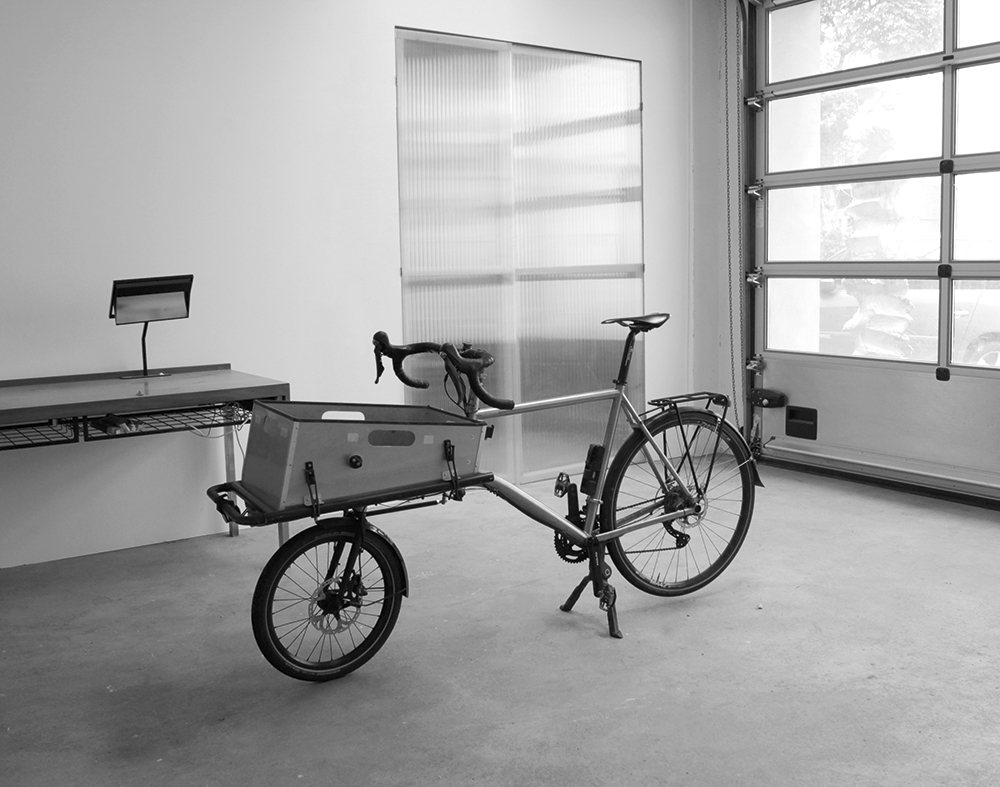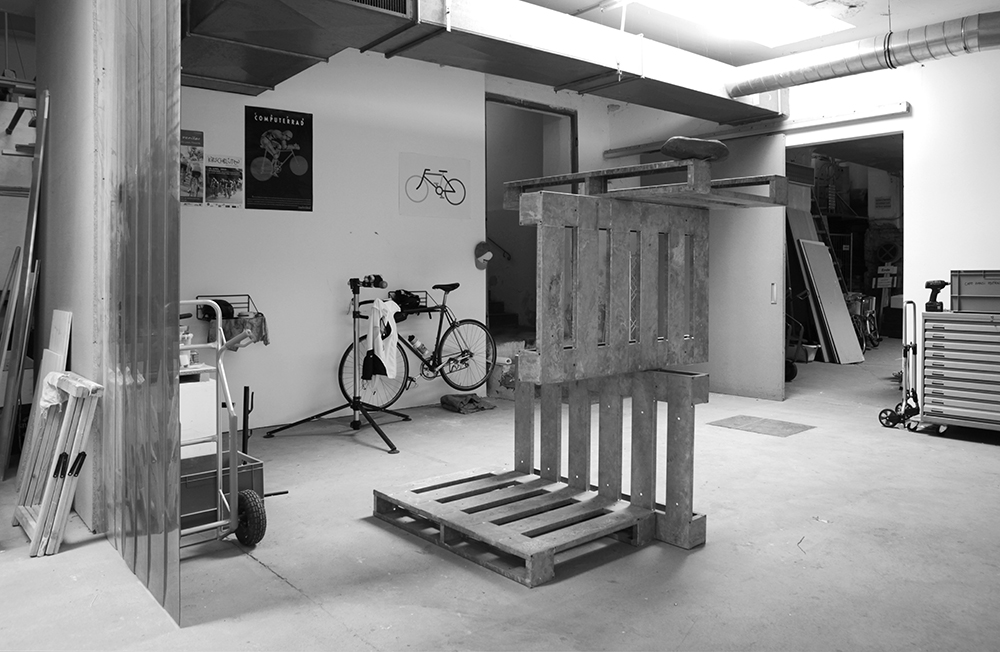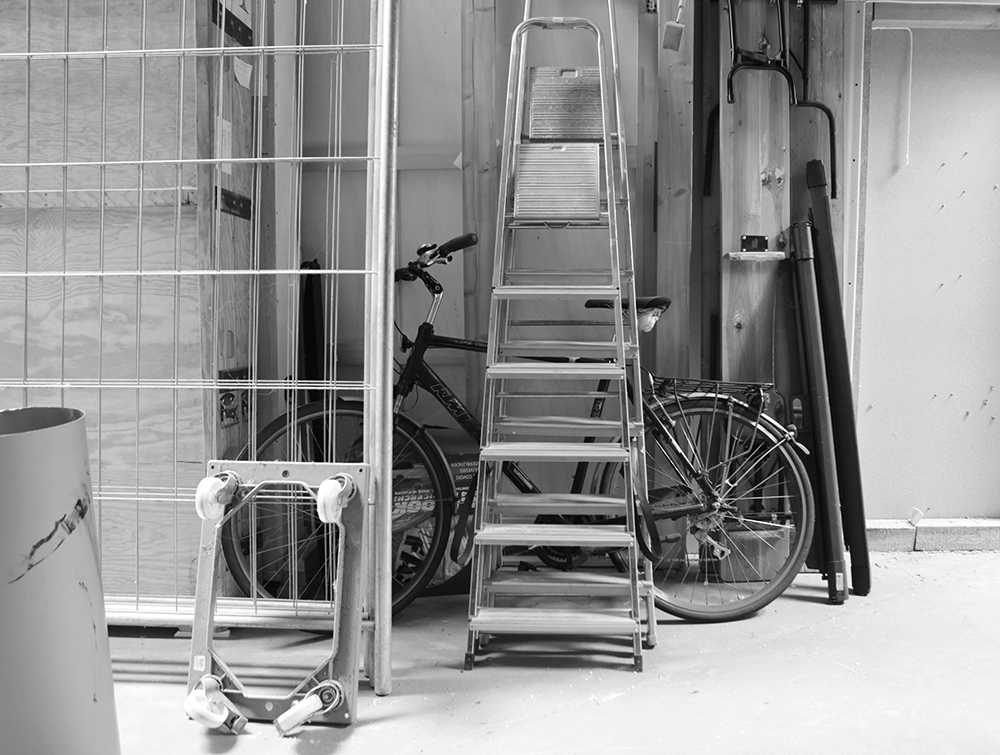Interview / Hans Schabus / Version 6
Version: Your work always revolves around movement. Why is movement in art so important to you?
Hans Schabus: I think that’s where my interest in sculpture comes from. Sculpture is a motif for movement; it doesn’t have a single ideal viewpoint like a painting, a photograph, theater, or cinema. You sit or stand and look at something, even if you move toward or away from it. Sculpture, however, needs to be experienced— it forms a very active field of reference to my body, demanding relationship in order to be understood. That’s why I am in motion. In a broader sense, sculpture is a tool to illustrate movement.
Version: In part, you also direct the movement sequences of the visitors, evoking movement—like with your stair sculptur—or setting yourself in motion, as with your cycling tours across America or from Northern to Southern Europe. You also consider the journey from the studio to the institution in your exhibitions.
Hans: Exactly, and that is already a reference, because it begins with an existential process or a questioning of one’s own situation: Where am I? What am I doing here? How do we even get there? And what is there? These fundamental questions about myself, my surroundings, and my counterpart lead to different approaches. Understanding the situation is the basis for decision-making. For me, experience beyond the visual is crucial—a physical perception of space, an exhibition, or an artwork. That’s why it’s also about activating the viewer, creating or questioning that relationship.
Version: Take the Kunsthaus Bregenz as an example. It seems as if you think your way from the studio to the Kunsthaus and beyond, as if the institution itself is irrelevant. It just happens to be there. “Institutional critique” might not be the right term, but your approach has something anarchic about it—you don’t really accept it.
Hans: I try to understand or contextualize the institution through its surroundings. Ideally, the institution becomes a waypoint on a journey. This is something that has preoccupied me from my first institutional exhibition at the Secession. It was an attempt to break and question representation—about literally finding other ways of working with the institution or of working your way into it. Simply finding alternative access points—not entering from the front, but from behind, below, or above—to show that fundamental concerns are at stake: What foundations is the institution built on? What are its hierarchies?
Version: But does that really matter? Ultimately, isn’t it just about the space, regardless of what name is on the building? Theoretically, it could be an empty storefront.
Hans: Yes, but let’s go back to the examples of the Secession and Kunsthaus Bregenz. I didn’t want people to enter the main space through the main entrance. It felt uncomfortable to submit to that significance. Or take the pavilion in Venice—I built over it, refusing to be absorbed by its structure, its meaning, and its representation. It’s about seeking the back entrance, the servant’s entrance, rather than the red carpet. On one hand, as you say, space is space, and space demands fundamental reflection, approaches, and interests. But for me, the way toward it is just as interesting—finding a different way rather than taking the most obvious route.
Version: So space as sculpture, one could say.
Hans: Absolutely, space is sculpture. The airspace within architecture is the largest possible sculpture. That’s what it’s really about.
Version: When you go on these cycling tours, there’s no architectural space—except when you’re on a train. How do you perceive that space as sculpture?
Hans: For me, it’s a form of measurement—a sculptural measurement. To put in reference or to put in a relation. When you do something like this, you have a lot of time to reflect on what space is, how it is structured, its composition, landscapes, societies. Where movement meets standstill, or supposed standstill, at the side of the road, incredibly interesting things happen. The tension that arises there intrigues me. I’m interested in movement in relation to stillness, my own movement or that of visitors in an exhibition, in contrast to solid architecture, to immobility.
Version: Measurement also involves marking points. Do you have a system, like sending a postcard every 20 kilometers?
Hans: I record the dates; I know my route. It’s really about finding a way to minimize decision-making along the journey. Ideally, I already know that today I will travel from point A to point B. Then, along the way, there’s nothing to do but get there. The freedom lies in this rigid framework of the route.
Version: You establish a grid, then follow a process. This work could exist as an artwork without any physical remnants.
Hans: That’s a fundamental question—what constitutes the artwork, or how does it manifest?
Version: Yet there are the ointments you exhibit, the dog leash, the postcards. And the film—a kind of time-lapse, 30 seconds per day. That’s something different from the journey itself. How does the process translate into art?
Hans: These are markers I set. Things that happen in between. But these markers don’t all carry the same amount of information. The question is, how do I extract meaning from my existence, my situation, my movement? I have always been interested in the calendar progression of things. Leibniz said, “Space is the order of simultaneously existing things, and time is the order of succession.” How do I understand myself within these phenomena, within this cosmos? I try to find a filter for experiencing certain processes. The studio represents the sedentary, if not outright immobility, and is contrasted with movement. What elements or structural considerations can I use to depict this? In this sense, a journey is an attempt to wrest something from the process. That is important to me as an artist. This is also the case with the daily 30-second video on the site. It may have something to do with control—or the loss of it. I don’t have to choose the best image. But through the accumulation of images, something emerges—I see how the landscape changes, how the continent reveals itself. These are things worth understanding. I wouldn’t say, “What is the actual artwork?” To me, it’s all interconnected.
Version: To extract structure from something ungraspable, and to show something through that structure?
Hans: It’s a form of cartography—whether in the studio, the landscape, or in movement.
Version: You’re not just working from the studio; you’re shifting spaces by exhibiting the „sedentary.“ On one hand, there’s the studio, as seen in the Secession, and then there’s the mobile bar—a container that can be placed anywhere. You’re also interested in the bar as a space itself—offering quick service, a place to meet people, and sometimes there are concerts. What was your intention behind creating a bar, especially a mobile one?
Hans: A bar is an important place for artists because we spend a lot of time alone, to activate from our margins the things that we want to depict in relation to society. That’s why bars have always been crucial negotiation spaces, where we can experience community and engage in conversation—whether discussing these topics directly or you simply get distracted. Fundamentally, a bar is an interesting medium for art. We know those tiny bars, those „Tschocherl,“ packed with personal mythology. I wanted to turn that inside out—bringing that accumulation of things outward while making the interior quite sober. In the gallery, I also wanted to be self-sufficient, meaning I had my own bathroom, water, and so on. The bar was open once a week after gallery hours. During opening hours, you could only walk around it, but not go inside. After opening hours once a week, you could go into the bar, but not around it. Other fundamental considerations for me were questions of exchange and economy—placing myself in a space dedicated to sales and presentation, serving drinks, charging for them, and creating a source of income within the gallery, but outside its usual hours.
Version: You’re essentially turning the private inside the professional, the distanced—like a womb.
Hans: Interesting, yes. At MUMOK, my challenge was finding a way to connect the bar with public space, as I couldn’t create a separate entrance on the museum’s ground floor. That’s why I wanted Café Hansi visitors to enter without paying museum admission—but still paying for drinks. When the bar was open, they could get a voucher at the ticket counter, and if they were clever, they might have checked out the exhibition instead of even going to the bar. But because access to the bar was free, it remained connected to public space. The motivations behind Café Hansi were questions of autonomy and sharing. Sharing is fundamental to what we do as artists—we live off the act of sharing, and a bar is a great way to illustrate that.
Version: You work a lot with text—literary titles, the printing plates in Galerie Krinzinger. What role does text play for you? Is it just another material, like stone or wood?
Hans: I see language as a tool for communication. When I work with text directly—like with the printing plates—it’s about dealing with information. Text is raw, structural information. Beyond that, certain titles or phrases serve to explore meaning and ideas. Language is a form of perception apparatus. To verbalize means to write down, to symbolize, to visualize—to discuss perception itself. Language is order, which means that I organize things and structure the relationships that happen at work or when dealing with certain topics. In this respect, language has many different qualities: on the one hand, fragmentation, and on the other, reassembly and the spaces that arise between the words or letters. Language creates blanks, but at the same time, it offers perspective, focus, and definition. This is comparable to the form of the waymarks.
Version: Were these collected printer plates or did you have them refurbished?
Hans: Not really. The printing companies told me they’re recycled quickly—printed on both sides, then shredded and melted down. We recreated those concert posters with precise information about events that didn’t take place due to the pandemic. Some I found online, others we reconstructed and re-exposed. Initially, I just wanted the plates for the installation, but then I printed them on China paper, front and back. It’s always important for me to find a break—to follow up a major work with something small, to take a different path, to create something ephemeral.
Version: That also includes the catalogs and artist books you create with graphic designer Dorothea Brunialti. They are essentially their own artistic works, like sculptures having a conversation with each other, the collection of rejection letters to Gordon Matta-Clark, or the Kunsthaus Bregenz calendar catalog.
Your 2005 Biennale project already contained the essence of everything you engage with. There is the movement, the videos of the journey, the cartographic confrontation, the reversal of inside and outside, there were these flaps through which you could look out and, of course, the mountain. How was that experience? The location isn’t exactly ideal for such a massive project.
Hans: I was already struggling with that… The Austrian Pavilion. My first instinct was—I don’t want to be inside. I wanted to be above it, behind it, in front of it—somewhere else. I started searching for a motif; before the mountain, I had other ideas. I considered a circus tent, a roller coaster, but then I landed on the mountain. I grew up right on the Italian border. As kids, we played in the trenches of World War I, finding remnants everywhere. That war was very present. The mountain is fascinating because it’s not just a form—it’s also a container. That connection to the Hoffmann Pavilion interested me. Hoffmann is one of Austria’s architectural icons. He built a pavilion, which he described as the gateway to the south. As soon as you were inside the gate, you were already outside again—there was a wall behind it, and behind that, another wall. I asked myself—what kind of gateway is this? At the far end of the Giardini, it was a pretty squalid situation – spatially – if you take that as a gate.
Version: There’s an interesting ambivalence in that location—you’re part of the Biennale, yet also detached from it. But what about that axial structure? Walking straight through feels more natural than turning left or right into the side rooms, which don’t really relate to contemporary art anymore.
Hans: Several aspects came into play. That island was only filled in at the end of the 19th century, along with the new harbor. Venice itself is stagnant—flat, with no real highs or lows. This method of reclaiming land by filling in the lagoon—that’s how they expanded. And for me it was a method of pouring over the pavilion.
Version: Recently, we’ve discussed the relationship between art, monuments, and national representation. How do you see that in this context?
Hans: It’s an act of assignment, an appropriation—but you can free yourself from it. That’s why my considerations revolved around self-empowerment. The word „pavilion“ comes from the butterfly, which shows its full beauty for a short time. And now we have a lot of pavilions there that are tombstones turned to cement. They are all listed buildings, incredibly old butterflies that have already lost their beauty. How do you engage with them? That led to my „barrack architecture“ made of tar paper and wood, titled The Last Land The best thing was that two days after the opening I was already on a plane to L.A. for the Schindler Fellowship. I was gone, barely following what happened afterward. In 2005, the internet was a different thing. You were exposed, used—by whoever, however.
Version: You studied with Bruno Gironcoli and now hold a professorship at the University of Applied Arts. How has the study experience changed? Back then, there were basically two paths—analog or digital. People questioned the concept of cities as the internet kept improving, and there was, of course, the new electronic music of the ‘90s. Today, the fractures are quite different.
Hans: Back then, studying was more emancipatory—about challenging society, finding new ways forward. The level of supervision was much lower compared to today. There are different structures now; students are embedded in various cycles, including international exchange. In that sense, I’m both a learner and a teacher, just as students are both teachers and learners. I observe myself—how I used to be, how I might be now. The great thing about youth is that is an almost unconditional forward-facing. And when we grow older, we realize how bigger and more powerful the back becomes and how much of a burden this back can be. It’s fascinating to see young people without that burden. That’s why it’s difficult for me to attribute to them how they might feel in relation to how I felt at the time. At the same time, I think we’re in a different world now, facing the consequences of our society in a much more immediate and comprehensive extent than we did when we were students 25 or 30 years ago. We no longer talk about an emancipatory space but about other consequences in relation to society.
Version: Would you say there’s more pressure to professionalize?
Hans: That pressure has always been strong. But maybe today, it’s harder to find a path. I don’t see it as training people for the art market—we’re working together on an aesthetic engagement with society. Experience and knowledge can also be limiting. That’s why youth is so important—it reminds us to keep moving forward.



